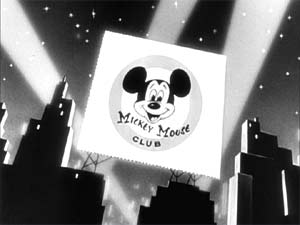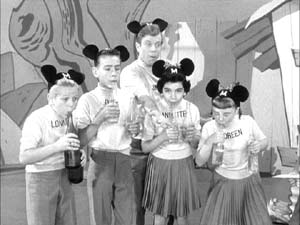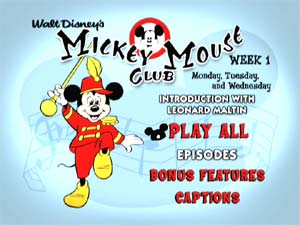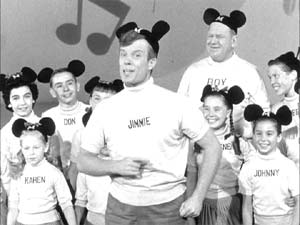| Reviews & Columns |
|
Reviews DVD TV on DVD Blu-ray 4K UHD International DVDs In Theaters Reviews by Studio Video Games Features Collector Series DVDs Easter Egg Database Interviews DVD Talk Radio Feature Articles Columns Anime Talk DVD Savant Horror DVDs The M.O.D. Squad Art House HD Talk Silent DVD
|
DVD Talk Forum |
|
|
| Resources |
|
DVD Price Search Customer Service #'s RCE Info Links |
|
Columns
|
|
|
Walt Disney Treasures: Mickey Mouse Club
Travel back in time with the Mouseketeers
 |
An afterschool favorite of the mid-1950s, the "Mickey Mouse Club" wasn't on the air for a relatively long time, just a few years in all, but it struck a chord with those who watched it, thanks to an uber-catchy theme song and a cast that resonated with viewers. A mix of variety show, cartoons and filmed pieces, it was an hour of television that entertained and informed, even if it was infused with the social mores of the '50s, not the most enlightened period of American history. Through cable repeats, later generations were able to enjoy it, and now, with these DVDs, the show can reach even more children, while allowing their parents and grandparents to reminisce.
Unlike in the repeats, these episodes are uncut, leaving in the full-length theme song (and the accompanying animation), promotional announcements (for companies like Ipana toothpaste and Sugar Jets cereal), the ABC Network announcements and the post-show ad for "The African Lion," one of Walt Disney's nature films. I've always thought it would be interesting if TV shows on DVD were released with their original commercials, as they have a historical value as well. This presentation proves that point.
Here's a breakdown of the five episodes enclosed:
Monday, October 3, 1955
The first ever "Mickey Mouse Club" kicks off with a Newsreel that, for some odd reason, promotes several Disney projects. Isn't it odd that the news would be promotional pieces? (Yes, I'm being sarcastic.) I got a particular kick out of the airboat piece about a Native American who holds a grudge against the white man, yet drives two kids through the swamps of Florida. You'd think they'd like a chaperone on board. For Fun with Music Day, a musical bit called "The Friendly Farmers" kills time, but is one of the least impressive bits in this set. It felt too simple for a show that didn't do that very often. The "Show Song" is more impressive, as it combines the kids' ability to sing and dance, and Roy's ability to draw, as he sketches out their songs.
 "What I Want to Be" kicks off here with noble intentions about helping children discover what kinds of futures are available, only to then lock them in based on their gender. Pat, a little girl with a dream to travel the world, is chosen by a representative of the Mickey Mouse Club to learn about being an airline hostess. She knows a certain boy who she thinks can be a pilot, but he doesn't believe in himself. But that has to wait until tomorrow, because it's Mousekartoon time. "Pueblo Pluto" features Mickey and Pluto in the Southwest. Highly detailed and well-painted, this is trademark Disney. Jimmie Dodd takes his spot as the closer, telling what's in store over the next week.
"What I Want to Be" kicks off here with noble intentions about helping children discover what kinds of futures are available, only to then lock them in based on their gender. Pat, a little girl with a dream to travel the world, is chosen by a representative of the Mickey Mouse Club to learn about being an airline hostess. She knows a certain boy who she thinks can be a pilot, but he doesn't believe in himself. But that has to wait until tomorrow, because it's Mousekartoon time. "Pueblo Pluto" features Mickey and Pluto in the Southwest. Highly detailed and well-painted, this is trademark Disney. Jimmie Dodd takes his spot as the closer, telling what's in store over the next week.
Tuesday, October 4, 1955
Guest Star Day introduces a British friend named Sooty, a mute bear hand-puppet, and his puppeteer. Though it looks stupid to start, whenever they close-in on him, it's cute as hell. I'll admit, I laughed a few times. The Guest Star happens to be Wally Boag. I don't think I need to say anymore considering how famous Wally Boag is. Oh that Wally Boag. Seriously, he was apparently a "stand-up entertainer" at Disneyland. Guests don't get any bigger than him and his talk-show act, which must have gone over every kid's head.
"What I Want to Be" continues with part two, where the object of Pat's affections, Duncan, has to show he has the goods with a gas-propelled plane. Pat stands by her man, even when things look glum, and in a moment of emotion that wouldn't fly today, threatens his foe with death. For her efforts, she's being sent to Hostess School, whether she likes it or not. With the drama over, it's Mousekartoon time, which is a Mickey and Pluto show, titled "Mickey's Kangaroo." Oddly, Pluto speaks (or rather thinks out loud) a first in my Pluto experience. This has the effect of making him the creepiest Disney character ever. Jimmie is back with a "final" word, this time about the importance of perseverance. He also slips in a Disney plug, for good measure.
Wednesday, October 5, 1955
Anything Can Happen Day lives up to its name with the Newsreel, which is a winner. The narrator seems upset when one child doesn't die in a boat crash, then we watch an African tribe burn their children's possessions in a manhood ritual. It only gets better from there, with swimming babies and junior rodeos. A gadget band performance by the Mouseketeers, using only items like bottles and cans, increases the weirdness, thanks to a bizarre Hawaiian-themes monologue by a "park cleaner."
"What I Want to Be," part four gets off to a great start with a sign on the door that says "Hostess School - Women Only." Once Pat gets ditched at Girl School, Duncan gets to have some fun, heading up to the control tower. Unlike later installments, Pat is completely forgotten about this time. That's just as well, as the Mousekartoon, "Mickey's Service Station," is waiting to go. Mickey, Donald and Goofy are all in on this one, a rather old episode, based on the guys' character models. This one is as silly as the Mickey cartoons get, going as far as having Goofy goose himself. Jimmie follows it up with a plea for kids to help their parents out around the house. Can't argue with that one.
Thursday, October 6, 1955
"No Fool," a musical Jiminy Cricket cartoon about bicycle safety, kicks things off, with dire warnings that would probably be cut in today's kid-safe environment. It's Circus Day, which means the show features a performance by a troupe of acrobats. By today's standards, it's nothing special, but back then, it must have been something else. The segment that stands out the most though has to be part four of "What I Want to Be," which focuses on the airline industry. Pat learns about the ridiculous career available for women at airlines, as she sees women go through a "makeup analysis," making sure her hair is the right length, he height and weight fall into the right standard and that she knows how to bend over correctly. I'm not kidding. Duncan, on the other hand, finds out about becoming a pilot, and all the interesting tools involved in making sure a flight goes just right. If I was a girl in 1955, I can imagine I would be a bit depressed.
 Annette handles the hosting duties for the Mousekartoon, "The Wise Little Hen," a story about what being lazy will get you, featuring an old-style Donald Duck. The level of detail is amazing when compared to the bargain-basement animation seen in modern cartoons. Just before the show wraps up with the familiar refrain, Jimmie gives a message about paying your own way. At least he was speaking the truth. If only kids heard this stuff today.
Annette handles the hosting duties for the Mousekartoon, "The Wise Little Hen," a story about what being lazy will get you, featuring an old-style Donald Duck. The level of detail is amazing when compared to the bargain-basement animation seen in modern cartoons. Just before the show wraps up with the familiar refrain, Jimmie gives a message about paying your own way. At least he was speaking the truth. If only kids heard this stuff today.
Friday, October 7, 1955
Talent Round-Up Day starts with a Mickey Mouse Club Newsreel, which shows what kind of freakiness was going on back in 1955. A twisted boxing match between 8-year-olds leads into a series of odd news bites. At least this one isn't quite as self-promoting as Monday's. As part of the Talent Round-Up, a young trumpeter plays two songs (though he looks to be faking it) and Cubby himself brings his dad and brother on-stage to deliver a pretty impressive drum performance. Part five of "What I Want to Be" has Pat nearing Stepford Wife status in her air hostess training, while Duncan is supposedly ready to handle a flight. These segments are one of the few parts of the series that really was troublesome. It's back to fun though as Bobby introduces the Mousekartoon, "Two-Gun Mickey," an early western starring Mickey and Minnie. A kid's cartoon featuring cigarette rolling and gunfighting is unheard of today, which makes this such an interesting artifact. Jimmie's back to deliver his message of the day, this time about being friendly.
The DVDs
Disney's split the first week of the "Mickey Mouse Club" between two DVDs, with Monday through Wednesday on disc one, and the rest on the second DVD. Each disc features an introduction by Leonard Maltin, shot at the Disney studios. The episodes are in their original full-frame black-and-white, while the menus are static and full-screen, with music from the show. Each episode has scene selections, and optional English captions to go with the Dolby Digital 2.0 soundtrack. The discs come packed in a double-thick white keepcase, inside the now signature collectible tin case. Inside the case is a "collectible art" card, which is a reprouction of the cover of the original sheet music to Dodd's "Mickey Mouse March," a numbered (out of 130,000) certificate of authenticity and a high-quality 6-page booklet that features the text version of Maltin's first-disc introduction, a content listing (with incorrect second-disc info) and some photos and art. Attached (by a thread of glue) to the back of the tin case is the rear art, which repeats the back cover of the keepcase.
The Quality
Considering the majority of the source materials found in his set are nearly 50 years old, the final product is very impressive. The shows do have some visible grain and dirt and scratches, but overall, the footage is very crisp. Obviously, there's not really any color (except in the bonus materials) but the tones in the old footage looks very good. I don't remember this video looking even close to this good when it was on TV. The new video in the bonus features is crisp and without any problems. The audio, presented in Dolby Digital 2.0, is as good as can be expected, with the songs and dialogue sounding as good as any TV show made today. It's so good that I could hear the words spoken clearer than the caption writer, who got several words wrong.
The Extras
The first disc has two special features, including a touching featurette on Dodd, "The Leader of the Club" (9:00). The musical talent behind the show and the adult presence on-screen, Dodd was apparently one of those "good people" who gave freely of himself and lived his life by the "Good Book." As Maltin says, he was perfect for this show, and that if he didn't exist, Disney would have had to invent him. Amazingly, unlike with most children's show hosts, none of the Mousketeers has a bad word to say about him. I was surprised to see the topic of religion is actually broached in the conversation, but it seems only appropriate for him. The ending of the segment, with a clip from the show, is spot-on and beautifully positioned as a tribute to Dodd.
Far less emotional is a set of three Still Galleries, broken up into "Inside the Clubhouse" (on the set), "Spreading the Word: Mouseke-Promotion" (marketing materials) and "Sketching the Ideas" (design concepts.) In all, there are 90 pieces to look at (54, 17 and 9 respectively in their categories), including black and white and color photos, interesting promotional items and concept sketches for props and sets. These are worth at least one spin through. Looking at the "Clubhouse" photos, they are so good, it almost seems like they were taken on the set of a modern movie about the Club. There's an instruction screen included in the galleries that explains how to navigate through it.
Disc Two has a trio of bonus features, starting with "Mouseke-Memories," (14:30) a reunion of six of the original Mousketeers (Sharon, Lonnie, Cubby, Bobby, Karen and Doreen), hosted by Leonard Maltin. (It will look familiar, as the footage for "The Leader of the Club" was shot at the same time.) The sit-down chat takes place on the original soundstage, in front of the original curtain backdrop. They talk about how they got on the show, their favorite memories and their castmates, including the late Roy and Jimmie, as well as Annette, who couldn't make it to the interview. This is light and fluffy material, but it's interesting to see the Mousketeers all grown up and to hear their stories.
Introduced by Maltin, "The Mouseketeers Debut at Disneyland" is a newly-constructed bit of footage using the original live black-and-white TV introduction of the Mouseketeers at the theme park and recently discovered color film of the event. A much larger group than the one that later appeared on TV, this cast performed the opening later used for the first Talent Round-Up. The color footage is so vibrant that it's hard to imagine that it's almost 50 years old.
 Maltin returns to introduce another new rarity, in the form of a color version of the "Mickey Mouse Club" animated open. Disney did the into theme in color and black-and-white, and the color version, which never aired, is outstanding. The quality and creativity is simply incredible. The coloring adds another dimension to what was already an outstanding piece of animation, making it just that much better. Truly a terrific find for animation buffs.
Maltin returns to introduce another new rarity, in the form of a color version of the "Mickey Mouse Club" animated open. Disney did the into theme in color and black-and-white, and the color version, which never aired, is outstanding. The quality and creativity is simply incredible. The coloring adds another dimension to what was already an outstanding piece of animation, making it just that much better. Truly a terrific find for animation buffs.
The Bottom Line
For any fan of television history, Disney or just the Mickey Mouse Club, this is a fascinating DVD set; a trip back to a very different time. In a way, it's sad to know this kind of show just wouldn't work today, because for all the politically incorrect things it incorporated, it was a wholesome and entertaining way for kids to learn and have fun. Thankfully, Disney doesn't seem to feel the need to deny history (at least for these discs) and gives us the original shows, no matter what they say. Though the extras seem a bit light for the cost of the set, the material is quite good, and should satisfy anyone who's ever wanted to put on the ears.
Francis Rizzo III is a native Long Islander, where he works in academia. In his spare time, he enjoys watching hockey, writing and spending time with his wife, daughter and puppy.Follow him on Twitter
*The Reviewer's Bias section is an attempt to help readers use the review to its best effect. By knowing where the reviewer's biases lie on the film's subject matter, one can read the review with the right mindset.
|
| Popular Reviews |
| Sponsored Links |
|
|
| Sponsored Links |
|
|
| Release List | Reviews | Shop | Newsletter | Forum | DVD Giveaways | Blu-Ray | Advertise |
|
Copyright 2024 DVDTalk.com All Rights Reserved. Legal Info, Privacy Policy, Terms of Use,
Manage Preferences,
Your Privacy Choices | |||||||













